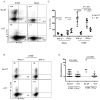Regulatory T-cell Response to Enterotoxigenic Bacteroides fragilis Colonization Triggers IL17-Dependent Colon Carcinogenesis
- PMID: 26201900
- PMCID: PMC4592451
- DOI: 10.1158/2159-8290.CD-15-0447
Regulatory T-cell Response to Enterotoxigenic Bacteroides fragilis Colonization Triggers IL17-Dependent Colon Carcinogenesis
Abstract
Many epithelial cancers are associated with chronic inflammation. However, the features of inflammation that are procarcinogenic are not fully understood. Regulatory T cells (Treg) typically restrain overt inflammatory responses and maintain intestinal immune homeostasis. Their immune-suppressive activity can inhibit inflammation-associated cancers. Paradoxically, we show that colonic Tregs initiate IL17-mediated carcinogenesis in multiple intestinal neoplasia mice colonized with the human symbiote enterotoxigenic Bacteroides fragilis (ETBF). Depletion of Tregs in ETBF-colonized C57BL/6 FOXP3(DTR) mice enhanced colitis but diminished tumorigenesis associated with shifting of mucosal cytokine profile from IL17 to IFNγ; inhibition of ETBF-induced colon tumorigenesis was dependent on reduced IL17 inflammation and was independent of IFNγ. Treg enhancement of IL17 production is cell-extrinsic. IL2 blockade restored Th17 responses and tumor formation in Treg-depleted animals. Our findings demonstrate that Tregs limit the availability of IL2 in the local microenvironment, allowing the Th17 development necessary to promote ETBF-triggered neoplasia, and thus unveil a new mechanism whereby Treg responses to intestinal bacterial infection can promote tumorigenesis.
Significance: Tregs promote an oncogenic immune response to a common human symbiote associated with inflammatory bowel disease and colorectal cancer. Our data define mechanisms by which mucosal Tregs, despite suppressing excessive inflammation, promote the earliest stages of immune procarcinogenesis via enhancement of IL17 production at the expense of IFNγ production.
©2015 American Association for Cancer Research.
Figures





Comment in
-
T Regulatory Cells Gone Bad: An Oncogenic Immune Response against Enterotoxigenic B. fragilis Infection Leads to Colon Cancer.Cancer Discov. 2015 Oct;5(10):1021-3. doi: 10.1158/2159-8290.CD-15-0987. Cancer Discov. 2015. PMID: 26429936
References
-
- Siegel R, Desantis C, Jemal A. Colorectal cancer statistics, 2014. CA Cancer J Clin. 2014;64:104–17. - PubMed
-
- Herrinton LJ, Liu L, Levin TR, Allison JE, Lewis JD, Velayos F. Incidence and mortality of colorectal adenocarcinoma in persons with inflammatory bowel disease from 1998 to 2010. Gastroenterology. 2012;143:382–9. - PubMed
-
- Bansal P, Sonnenberg A. Risk factors of colorectal cancer in inflammatory bowel disease. Am J Gastroenterol. 1996;91:44–8. - PubMed
Publication types
MeSH terms
Substances
Grants and funding
LinkOut - more resources
Full Text Sources
Other Literature Sources
Molecular Biology Databases

